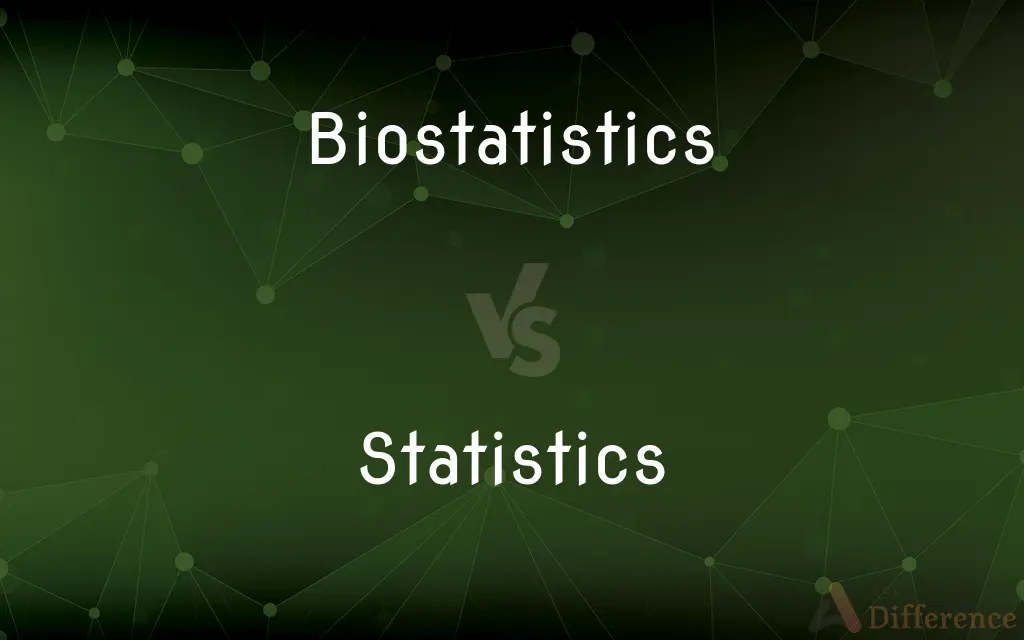Biostatistics vs. Statistics — What's the Difference?
By Tayyaba Rehman — Updated on November 2, 2023
Biostatistics applies statistical methods to biological research, while statistics is the broader field involving data collection, analysis, interpretation, and presentation.

Difference Between Biostatistics and Statistics
Table of Contents
ADVERTISEMENT
Key Differences
Biostatistics is a discipline that involves the application of statistical methods to biological, health, and medical sciences. Statistics is the science of collecting, analyzing, and interpreting data in any field.
Biostatistics often focuses on designing biological experiments and clinical trials. Statistics covers a wider range of topics, not limited to the health sciences, including business, engineering, and social sciences.
In biostatistics, the data analyzed are typically related to living organisms and their health. In statistics, data can be from any source, including scientific, social, or economic domains.
The methods in biostatistics are specialized to deal with the challenges of biological data, like variability in life processes. Statistics uses general methods that can be applied across various types of data and research questions.
Biostatisticians work on problems like estimating survival rates in patients. Statisticians may work on diverse problems, from forecasting economic trends to quality testing in manufacturing.
ADVERTISEMENT
Comparison Chart
Definition
Applies statistics to biological fields.
The science of data analysis in any field.
Focus
Biological, medical, and health sciences.
All-encompassing, including any field.
Data Types
Mainly health and life sciences data.
Diverse: economic, industrial, social, etc.
Methodology
Tailored to life science variability and study design.
Broad and adaptable to various disciplines.
Typical Applications
Clinical trials, epidemiology, genetics.
Market analysis, census data, quality control.
Compare with Definitions
Biostatistics
Biostatistics is the analysis of data from biological experiments and health studies.
The biostatistics report revealed a new trend in the patient recovery rates.
Statistics
Statistics is the field that applies mathematical concepts to data for interpretation.
He published a paper on new statistics methods for financial data.
Biostatistics
Biostatistics deals with the statistical processes in the field of medicine and biology.
His biostatistics expertise helped in understanding the drug's impact on cancer cells.
Statistics
Statistics helps in designing surveys and experiments for reliable conclusions.
Statistics will determine how we sample populations for our research.
Biostatistics
Biostatistics applies mathematical theories to biological problems.
In biostatistics class, we learned how to design experiments for clinical trials.
Statistics
Statistics is the science of collecting, analyzing, and making inferences from data.
They used statistics to predict the election outcomes.
Biostatistics
Biostatistics involves designing and applying statistical methods to life sciences.
She's studying biostatistics to improve her skills in medical research analysis.
Statistics
Statistics involves numerical data analysis for decision-making.
The company's statistics showed a 10% increase in sales this quarter.
Biostatistics
Biostatistics is used to interpret the quantitative aspects of health sciences.
Biostatistics was crucial in evaluating the effectiveness of the new vaccine.
Statistics
Statistics is the discipline that concerns the collection, organization, analysis, interpretation, and presentation of data. In applying statistics to a scientific, industrial, or social problem, it is conventional to begin with a statistical population or a statistical model to be studied.
Biostatistics
Biostatistics (also known as biometry) are the development and application of statistical methods to a wide range of topics in biology. It encompasses the design of biological experiments, the collection and analysis of data from those experiments and the interpretation of the results.
Statistics
The practice or science of collecting and analysing numerical data in large quantities, especially for the purpose of inferring proportions in a whole from those in a representative sample.
Biostatistics
The branch of statistics that deals with data relating to living organisms.
Statistics
(used with a sing. verb) The mathematics of the collection, organization, and interpretation of numerical data, especially the analysis of population characteristics by inference from sampling.
Biostatistics
Application of statistics to the analysis of biological and medical data.
Statistics
(used with a pl. verb) Numerical data.
Biostatistics
The application of statistics to the study and analysis of biological and medical data
Statistics
A discipline, principally within applied mathematics, concerned with the systematic study of the collection, presentation, analysis, and interpretation of data.
Statistics is the only mathematical field required for many social sciences.
Biostatistics
Plural of biostatistic
Statistics
The science which has to do with the collection, classification, and analysis of facts of a numerical nature regarding any topic.
Biostatistics
Vital statistics.
Statistics
Classified facts of a numerical nature regarding any topic.
Statistics
The branch of mathematics which studies methods for the calculation of probabilities.
Statistics
A branch of applied mathematics concerned with the collection and interpretation of quantitative data and the use of probability theory to estimate population parameters
Statistics
Statistics is used to understand and solve problems in various sectors.
Urban planners use statistics to forecast future housing needs.
Common Curiosities
What is biostatistics?
Biostatistics is the application of statistical techniques to scientific research in health-related fields, including medicine and biology.
What do biostatisticians do?
Biostatisticians design studies, analyze data from medical research, and help interpret the findings in the context of health.
What is the main focus of biostatistics?
The main focus is on applying statistical methods to the analysis of data in the biological and health sciences.
Are statistical methods consistent across fields?
Yes, statistical methods are adaptable, though they may be tailored to meet the specific needs of different fields.
Why is biostatistics important in medicine?
Biostatistics is crucial for determining the effectiveness of treatments, understanding public health trends, and making medical decisions based on evidence.
Can biostatistics be used outside of medicine?
Yes, while it's tailored for health sciences, biostatistics can also be applied to any biological sciences data.
Who uses statistics?
Researchers, government agencies, businesses, and many other professionals use statistics for informed decision-making.
What role does statistics play in research?
Statistics helps in designing experiments, analyzing data, and drawing valid conclusions in research.
How is data analyzed in biostatistics?
In biostatistics, data is analyzed through models and methods that take into account the variability of biological processes.
Can biostatistics be self-taught?
While it is complex, with enough dedication, one can self-learn biostatistics, especially with the vast resources available today.
How do statistics help in everyday life?
Statistics help in making informed decisions, understanding trends, and evaluating risks in everyday life.
What are the types of statistics?
There are two main types: descriptive statistics that summarize data and inferential statistics that draw conclusions from data.
What is statistics?
Statistics is the study of data collection, analysis, interpretation, and presentation across various fields.
Is mathematics a prerequisite for statistics?
Yes, a solid understanding of mathematics is important for studying and applying statistical methods.
What educational background is needed for biostatistics?
Typically, a background in health sciences, mathematics, or statistics is needed to pursue a career in biostatistics.
Share Your Discovery

Previous Comparison
Presents vs. Present
Next Comparison
Grease vs. TallowAuthor Spotlight
Written by
Tayyaba RehmanTayyaba Rehman is a distinguished writer, currently serving as a primary contributor to askdifference.com. As a researcher in semantics and etymology, Tayyaba's passion for the complexity of languages and their distinctions has found a perfect home on the platform. Tayyaba delves into the intricacies of language, distinguishing between commonly confused words and phrases, thereby providing clarity for readers worldwide.














































